Centauri Dreams
Imagining and Planning Interstellar Exploration
Interstellar Journey: Shrinking the Probe
We’ve all imagined huge starships jammed with human crews, inspired by many a science fiction novel or movie. But a number of trends point in a different direction. As we look at what it would take to get even a robotic payload to another star, we confront the fact that tens of thousands of tons of spacecraft can deliver only the smallest of payloads. Lowering the mass requirement by miniaturizing and leaving propellant behind looks like a powerful option.
Centauri Dreams regular Alex Tolley pointed to this trend in relation to The Planetary Society’s LightSail-1 project. In a scant ten years, we have gone from the earlier Cosmos 1 sail with an area of 600 square meters to LightSail-1, with 32 square meters, but at no significant cost in scientific return because of continuing miniaturization of sensors and components. We can translate that readily into interstellar terms by thinking about future miniature craft that can be sent out swarm-style to reach their targets. Significant attrition along the way? Sure, but when you’re building tiny, cheap craft, you can lose some and count on the remainder to arrive.
The Emergence of SailBeam
I inevitably think about Jordin Kare’s SailBeam concepts when I hear thinking like this. Kare, a space systems consultant, had been thinking in terms of pellet propulsion of the kind that Clifford Singer and, later, Gerald Nordley have examined. The idea here was to replace a beam of photons from a laser with a stream of pellets fired by an accelerator — the pellets (a few grams in size) would be vaporized into plasma when they reached the spacecraft and directed back as plasma exhaust. Nordley then considered lighter ‘smart’ pellets with onboard course correction.
I’m long overdue for a re-visit to both Singer and Nordley, but this morning I’m thinking about Kare’s idea of substituting tiny sails for the pellets, creating a more efficient optical system because a stream of small sails can be accelerated much faster close to the power source. Think of a solar sail, as Kare did, divided into a million pieces, each made of diamond film and being accelerated along a 30,000 kilometer acceleration path, all of them shot off to drive a larger interstellar probe by being turned into a hot plasma and pushing the probe’s magnetic sail.

Image: Jordin Kare’s ‘SailBeam’ concept. Credit: Jordin Kare/Dana G. Andrews.
Kare, of course, was using his micro-sails for propulsion, but between Nordley and Kare, the elements are all here for tiny smart-probes that can be pushed to a substantial fraction of the speed of light while carrying onboard sensors shrunk through the tools of future nanotechnology. Kare’s sails, in some designs, get up to a high percentage of c within seconds, pushed by a multi-billion watt orbiting laser. Will we reach the point where we can make Kare’s sails and Nordley’s smart pellets not the propulsion method but the probes themselves?
In that case, the idea of a single probe gives way to fleets of tiny, cheap spacecraft sent out at much lower cost. It’s a long way from LightSail-1, of course, but the principle is intact. LightSail-1 is a way of taking off-the-shelf Cubesat technology and giving it a propulsion system. Cubesats are cheap and modular. Equipped with sails, they can become interplanetary exploration tools, sent out in large numbers, communicating among themselves and returning data to Earth. LightSail’s cubesats compel anyone thinking long-term to ask where this trend might lead.
A Gravitational Lensing Swarm
In Existence, which I think is his best novel, David Brin looks at numerous scenarios involving miniaturization. When I wrote about the book in Small Town Among the Stars, I was fascinated with what Brin does with intelligence and nanotechnology, and dwelled upon the creation of a community of beings simulating environments aboard a starship. But Brin also talks about a concept that is much closer to home, the possibility of sending swarms of spacecraft to the Sun’s gravitational focus for observation prior to any star mission.
We normally speak about the distance at which the Sun’s gravity bends light from objects on the other side of it as being roughly 550 AU, but effects begin closer than this if we’re talking about gravitons and neutrinos, and in Brin’s book, early probes go out here, between Uranus and Neptune, to test the concept. But get to 550 AU and beyond and photon lensing effects begin and continue, for the focal line goes to infinity. We have coronal distortion to cope with at 550 AU, but the spacecraft doesn’t stop, and as it continues ever further from the Sun, we can be sampling different wavelengths of light to make observations assisted by this hypothesized lensing.
Before committing resources to any interstellar mission, we want to know what targets are the most likely to reward our efforts. Why not, then, send a swarm of probes. Claudio Maccone, who has studied gravitational lensing more than any other physicist, calls his design the FOCAL probe, but I’m talking about its nanotech counterpart. Imagine millions of these sent out to use the Sun’s natural lens, each with an individual nearby target of interest. Use the tools of future nanotech and couple them with advances in AI and emulation and you open the way for deep study of planets and perhaps civilizations long before you visit them.
The possibilities are fascinating, and one of the energizing things about them is that while they stretch our own technology and engineering well beyond the breaking point, they exceed no physical laws and offer solutions to the vast problems posed by the rocket equation. Perhaps we’ll build probes massing tens of thousands of tons to deliver a 100 kilogram package to Alpha Centauri one day, but a simultaneous track researching what we can do at the level of the very small could pay off as our cheapest, most effective way to reach a neighboring star.
More on this tomorrow, as I take a longer look at Clifford Singer and Gerald Nordley’s ideas on pellet propulsion. I want to use that discussion as a segue into a near term concept, Mason Peck’s ideas on spacecraft the size of computer chips operating in our Solar System.
And today’s references: Cliff Singer’s first pellet paper is “Interstellar Propulsion Using a Pellet Stream for Momentum Transfer,” JBIS 33 (1980), pp. 107-115. Gerald Nordley’s ideas can be found in “Beamriders,” Analog Vol. 119, No. 6 (July/August, 1999). Jordin Kare’s NIAC report “High-Acceleration Micro-Scale Laser Sails for Interstellar Propulsion,” (Final Report, NIAC Research Grant #07600-070, revised February 15, 2002) can be found on the NIAC site.

Exploring the Galaxy’s Outer Halo
Not long ago we talked about what the Milky Way would look like when seen from afar. I had mentioned Poul Anderson’s World Without Stars, which appeared in Analog in 1966 under the title The Ancient Gods. In the Anderson tale, a starship crew is sent to make contact with a recently discovered technological civilization that lives on a world hundreds of thousands of light years from the galactic core. Now a recent paper deepens our understanding of this environment deep in the galaxy’s outer halo.
Recall that the Milky Way is about 100,000 light years in diameter, and that the distance to the nearest large galaxy is roughly 2,500,000 light years. Anderson’s crew is over 200,000 light years from the core, which puts them in the outer halo, a sparse spherical volume of space that stretches out 500,000 light years, well beyond the familiar, highly visible disk. While the stars in the galactic disk are on nearly circular orbits in the plane of the galaxy, the halo stars are on more elliptical orbits that are randomly oriented, so that while inner halo stars can pass through the disk, most of their lives are spent well above or below the plane of the galaxy. The inner, visible part of the halo is where we find the ancient, metal-poor globular clusters.
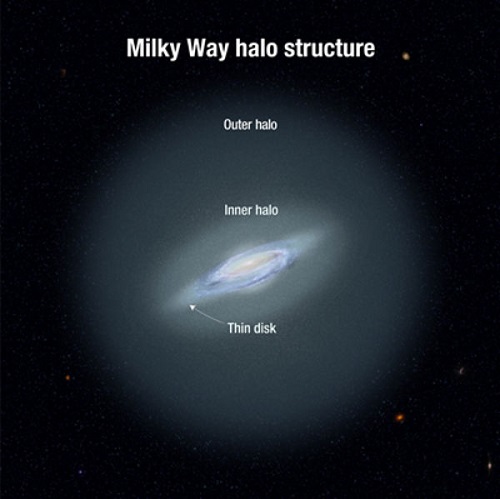
Image: Structure of the Milky Way, showing the inner and outer halo. Credit: NASA, ESA, and A. Feild (STScI).
Astronomer John Bochanski (Haverford College, PA) and team, however, are looking out well beyond the globular clusters. The researchers note in their paper in The Astrophysical Journal Letters that there are few known outer halo stars at distances over 120 kiloparsecs, which works out to about 390,000 light years — in fact, the list of known halo stars at this distance yields a grand total of seven, with the paper adding an additional two. The galaxy’s outer halo, we learn, is largely unexplored, but as we’ll see, it holds implications for galaxy formation theories.
The team’s recent paper outlines the discovery of two cool red giants — ULAS J0744+25 and ULAS J0015+01 — that appear to be the most distant Milky Way stars yet detected, at distances of 775,000 and 900,000 light years respectively. The work draws on observations from the UKIRT Infrared Deep Sky Survey and Sloan Digital Sky Survey, with spectroscopic studies using the 6.5m telescope at the MMT Observatory in Arizona. The newly discovered stars are five times more distant than the Large Magellanic Cloud and almost a third of the way to the Andromeda galaxy. At these distances, both Andromeda and the Milky Way should appear quite faint in the visible spectrum. If Anderson’s crew were here, the night sky would be dark indeed.
The image below brightens the Milky Way to give some sense of its distance from these stars.
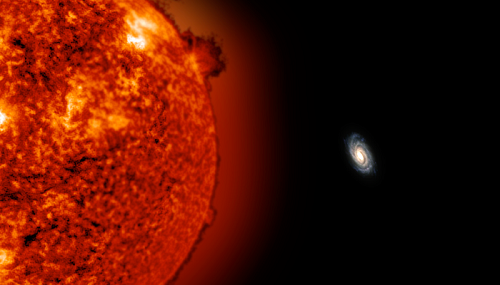
Image: This simulated image demonstrates how small the Milky Way would look from the location of ULAS J0744+25, nearly 775,000 light years away. This star, along with ULAS J0015+01, are the most distant stars ever associated with our Galaxy, and are about five times further away than the Large Magellanic Cloud, one of the Milky Way’s closest galactic neighbors. Credits: Visualization Software: Uniview by SCISS Data: SOHO (ESA & NASA), John Bochanski (Haverford College) and Jackie Faherty (American Museum of Natural History and Carnegie Institute’s Department of Terrestrial Magnetism).
Bochanski’s team has been looking at formation models for the Milky Way, an interesting issue given that, as he explains, “Most models don’t predict many stars at these distances. If more distant red giants are discovered, the models may need to be revised.” The halo itself may be the result of mergers over the galaxy’s lifetime with numerous smaller galaxies, with outer stars the remnant population of what had once been intact dwarf galaxies. If this is correct, we can study these outer halo stars as a way of probing the formation history of the entire spiral. The team hopes to identify up to 70 red giants in the halo, refining its selection criteria and aiding next generation surveys like Gaia that will help us deepen our catalog in this distant region.
The paper is Bochanski et al., “The Most Distant Stars in the Milky Way,” The Astrophysical Journal Letters, Volume 790, Issue 1, article id. L5 (abstract / preprint).

Reflections on the LightSail Project
I was delighted to see Doug Stetson, the program manager for The Planetary Society’s LightSail effort, quoting Johannes Kepler in last night’s webcast. If you missed the Pasadena event, which took place at the KPCC Crawford Family Forum in Pasadena, CA, you can watch the recorded session here, and I highly recommend it. Kepler’s 1610 letter to Galileo added context to the excitement over LightSail, for solar sailing has a rich history. Kepler wrote of providing “ships or sails adapted to the heavenly breezes,” and added that “there will be some who will brave even that void.”
It’s an inspiring thought as we now look into the launch of a privately funded sail that can join IKAROS and NanoSail-D in a series of operational experiments that will hone our sail knowledge. The chief news of the Pasadena meeting was the announcement of an approximate launch date. LightSail-1 is scheduled to go into space aboard a SpaceX Falcon Heavy rocket in April of 2016. The quick video Mat Kaplan showed illustrating the Falcon Heavy in flight was likewise energizing: This is a booster made up of three Falcon 9 cores, meaning 27 rocket engines. The Planetary Society’s Jim Bell calls it a rocket that ‘opens up the outer Solar System.’
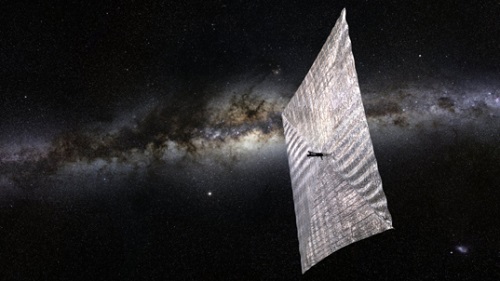
Image: Artist’s concept of LightSail in space. Credit: Josh Spradling / The Planetary Society.
But let’s clear up that problem of sail nomenclature I referenced yesterday. What is being called LightSail-1 is the designation for two solar sail CubeSats, LightSail-A and LightSail-B. Whether LightSail-A or LightSail-B is the one to fly next depends upon systems tests that will be completed in coming months, as Jason Davis explains in LightSail Update: Launch Dates:
If LightSail-A goes to space, it won’t reach a high enough altitude for the momentum it gains from solar sailing to overcome atmospheric drag. The spacecraft will deploy its sails, capture images, and communicate with the ground, giving engineers a chance to work through any problems en route to a full-fledged solar sailing flight.
LightSail-B, on the other hand, will embark upon true solar sailing, using the momentum of solar photons to increase its velocity. Usefully, both missions now seem likely to fly. Stetson told the Pasadena audience that an opportunity exists for launching LightSail-A to a lower orbit, a test flight that would occur in May of 2015. Joining the crowd by Skype, he went on to say that a test like this would validate the sail by putting it through a full deployment in lower Earth orbit.
The image below, shown by Stetson during the presentation, shows LightSail-B capturing forward momentum from solar photons. You can see the changes in attitude as the sail, orbiting the Earth, adjusts its position to maximize the effect of sunlight. Ultimately, turning the sail at key points in the orbit allows the orbit to be raised, allowing the prospect of escaping Earth’s orbit entirely. We can envision a day when CubeSats, those tiny marvels of inexpensive engineering, could be equipped with sails and sent out in swarms to explore the Solar System.
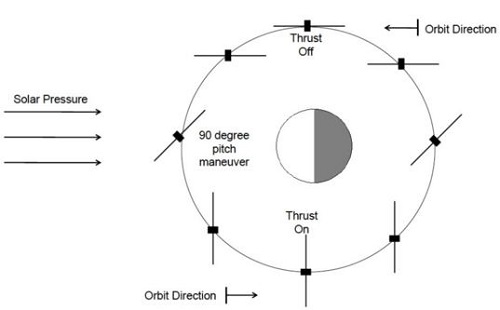
Image: In order to capture forward momentum from the sun’s rays, LightSail-1 will make two 90 degree pitches during an orbit. Credit: LightSail Team / The Planetary Society.
Planetary Society CEO Bill Nye refers to solar sailing in terms of power, utilizing ‘a fusion reactor at a safe distance, the Sun.’ Assuming we get LightSail-B into space in the spring of 2016, the surrounding package will be quite interesting. LightSail will launch embedded within a satellite called Prox-1. The latter, developed at Georgia Tech, was designed to conduct autonomous proximity operations in which two spacecraft operate at close quarters. Prox-1 will release the sail and then rendezvous with it, closing to within fifty meters and capturing images of LightSail. The actual sail deployment will occur after several weeks of operations.
We’re going to get some remarkable video of sail deployment, both from the cameras aboard the LightSail craft as well as those aboard Prox-1. System engineer Barbara Plante (Boreal Space/Ecliptic Enterprises) went on to discuss spacecraft attitude control after showing the crowd a large piece of the 4.5 micron sail material, roughly 1/50th the width of a human hair. Sail packaging and deployment is complicated business, but Plante said she was struck by the elegance of the design, referring to solar sailing as a ‘green method’ for exploration.
Looking to the future, David Brin joined the group by Skype as the panel discussed the implications of today’s sail experiments. Solar sails run into the obvious problem of diminishing sunlight the farther one goes from our star. The way around that problem is to imagine a future space infrastructure for power generation, one in which power is readily available for large laser arrays that can illuminate a sail and push it entirely out of the Solar System. Brin suggested the Sun’s gravitational lens at 550 AU and beyond as a natural target for later generation sails, a way of exploiting the extreme magnifications this natural lensing provides for our instruments.
For me, the word ‘lightsail’ has always referred to a sail under this kind of beamed power, and now I’ll have to be careful not to confuse that kind of sail with the experiments LightSail-1 will offer in nearby space. But we always need to think about how today’s efforts play into a larger scenario, including so-called ‘Sundiver’ missions that unfurl their sails after a close pass by the Sun to achieve high accelerations. It seems fitting to end this piece on LightSail-1 with Louis Friedman’s thoughts on such missions, he being a key player in making this happen.
Friedman, as we’ve seen, worked at the Jet Propulsion Laboratory on the design of a large sail targeting Comet Halley, and although that mission never flew, he has been an advocate of sail designs for decades, anticipating that we would one day understand the virtues of leaving propellant behind and shedding the rocket equation altogether. In his 1988 book Starsailing: Solar Sails and Interstellar Travel, he brings his experience to the long view:
[The sail] would provide a nearly perfect means of interstellar travel — except that it requires sunlight, and we will run out of that as we leave the solar system, a circumstance that could leave us becalmed, like a terrestrial sailboat on a windless ocean. We could, however, use a series of gravity assist maneuvers to keep ourselves moving along. We could fly around Jupiter, for instance, then head in toward the sun, picking up a lot of speed with our sail. Then we could swing around and head out past Jupiter and Saturn, picking up even more speed. With a large sail and with a close fly-by of the sun, assuming good thermal protection, we could conceivably exit the solar system at a rate of 40 astronomical units a year — in other words, we could travel through the whole solar system in about 1 year. Even at that great a speed, however, we would not reach the second star for 6,600 years! Not so good. Nevertheless, this use of gravity assist and solar sailing combined offers real promise for the use of solar sails even for traveling to the outer planets, which may extend the range of the interplanetary shuttle.
But Friedman has interstellar thinking in his bones. Intimately familiar with the work of Robert Forward, he goes on to describe the latter’s concept of a 3.6 kilometer sail that would, using laser beaming technologies, get a one-ton payload to Alpha Centauri in about 40 years, reaching a bit more than one-tenth of lightspeed. It was one of many Forward designs that speculate on what a human presence in space and the immense power of directed light could accomplish.
After the years at JPL, working with Bruce Murray and Carl Sagan, the time on Voyager, the 32 years as executive director of The Planetary Society, Louis Friedman, one of its founders, is seeing yet another result of his efforts pay off. I can assure you that when LightSail-1 flies, we’ll pop open a bottle of Champagne at my house, and the first toast of the evening will go to him.

Focus on LightSail-A
As Cosmos 1 demonstrated, launching solar sails isn’t always easy. The Planetary Society’s sail perished thanks to a malfunctioning Volna booster not long after launch in 2005. When NASA attempted to launch its NanoSail-D in 2008, a problem aboard the Falcon 1 booster destroyed the craft. And when the agency launched the backup, NanoSail-D2, in December of 2010, the CubeSat-based sail failed to eject from the FASTSAT satellite it was aboard. Just when all seemed lost, NanoSail-D2 ejected on its own on January 17, 2011 and deployed its sail soon after.
Now we’re looking at a new Planetary Society venture called LightSail-A, which grows out of the NanoSail-D project and, according to news that should be firmed up tonight, should be ready for launch in the near future. As with Cosmos 1, the funding for LightSail-A was raised from private sources and Planetary Society membership dues, with the spacecraft itself being built by Stellar Exploration Inc. out of San Luis Obispo, CA. With mylar sails 4.5 microns thick, the sail will extend upon deployment to cover 32 square meters. Three CubeSat spacecraft form a ‘bus’ about the size of a shoebox that weighs in at no more than 4.5 kilograms.
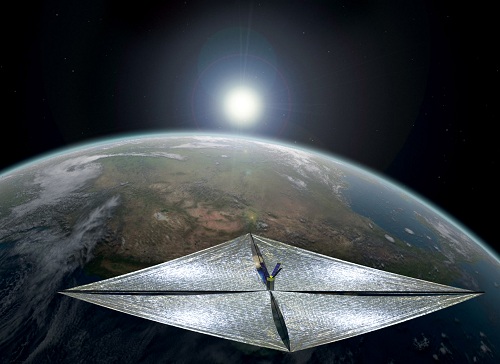
Image: The Planetary Society’s LightSail-1 will test out solar sail technologies in Earth orbit as a prelude for later missions including solar storm monitoring at L1. Credit: The Planetary Society/Rick Sternbach.
Back in June, the Planetary Society’s Jason Davis described recent LightSail-A activity:
During the past two years, LightSail has come of age. The solar sail itself demonstrated a full deployment back in 2011, but the guts of the spacecraft were far from mature. Project manager Doug Stetson and his team have been shaking out bugs and overhauling LightSail’s electronics, attitude control, software and communications systems. Next up is a full “day in the life” flight system test on Wednesday, June 4 that includes another sail deployment and full operation of the spacecraft as if it were in orbit. I’ll be on hand at Cal Poly San Luis Obispo to observe and report.
The test in question had to be delayed because of problems involving the TRAC (Triangular Rollable and Collapsible) boom system so crucial in proper deployment of the sail. A breakdown of the three deployment problems the team uncovered is here. Later testing on June 24 showed that fixes for the power anomalies, spacecraft processor overload and other boom deployment issues seem to have worked. Davis has made a video of the June 24 deployment test available; he’s also offering regular updates explaining technical features of the diminutive spacecraft.
The LightSail project involves three craft, the goal of the first being to test deployment and basic operations at an altitude of 800 kilometers. A second mission, LightSail-B, will collect scientific data and demonstrate controlled solar sailing, while a third has the ambitious goal of reaching the L1 Lagrangian point, a useful position from which to detect solar activity producing geomagnetic storms.
At this point it’s always a good idea to distinguish between the phenomenon LightSail-A will be exploiting — the momentum imparted by solar photons — and that other means of ‘sailing’ through space, the solar wind. The sailing metaphor is what can make this confusing. The solar wind consists of particles streaming out from the Sun, moving much slower than the speed of light and offering a push to spacecraft designed to exploit them. So-called ‘magsails’ are under study that could use the solar wind for fast interplanetary transport, but the force from the solar wind is a thousand times less than the photon force a solar sail can draw on in its operations. By ‘solar sailing,’ then, I refer to drawing on the momentum imparted by massless photons.
We’ll know more about LightSail-A’s shakedown cruise this evening, when The Planetary Society hosts a live webcast from 2200-2330 EDT (0200-0330 UTC), billed as the venue for “a major announcement about our solar sail spacecraft.” Expect a tour inside the cubesat and presentations by the engineers behind it, as well as an announcement about its launch. Confusingly, The Planetary Society is referring to its sail as both LightSail-A and LightSail-1, but I suspect that by the time the evening is over, we’ll have the basic nomenclature set.

Cosmos 1 in Context
We’re coming up on the tenth anniversary of Centauri Dreams, and it doesn’t surprise me even remotely that two of the earliest stories I ever wrote for the site involve solar sails. August 17, 2004’s Solar Sail Test by Japan talks about the Japanese Institute of Space Astronautical Science testing sail deployment strategies, and the August 14 entry, Cosmos 1 Solar Sail Closer to Launch, briefly describes the privately funded sail that was developed by The Planetary Society’s efforts, with financial contributions from members and major backing from Ann Druyan’s Cosmos Studios.
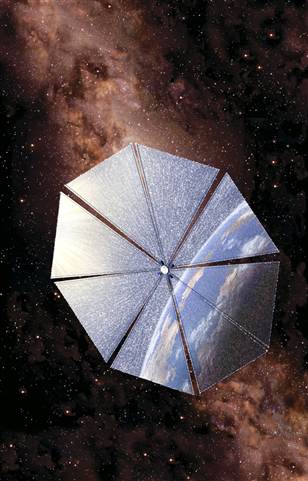
I’ve been fascinated with space sailing since first encountering the notion in 1960s-era science fiction, particularly Clarke’s “The Wind from the Sun” and Cordwainer Smith’s “The Lady Who Sailed the Soul.” What I lacked back then, though, was an appreciation for the challenge posed by the rocket equation, which demands so much more propellant the faster you want to go. Space missions demand huge mass ratios (the weight of the fueled rocket compared to the same rocket without fuel), and a chemical rocket on a deeply ill-advised Alpha Centauri mission would, to reach the target within a human lifetime, demand an amount of propellant larger than all the mass in the observable universe. Rocket scientists call that sort of thing a ‘showstopper.’
Image: An artist’s conception of Cosmos 1. Credit: Rick Sternbach.
So using solar photons to impart momentum while leaving heavy propellant out of the vehicle entirely makes eminent sense, but it’s been a long, slow road from theory to implementation. We saw yesterday that sail ideas got a serious bump in interest when Jerome Wright, who had been studying sail techniques, began to look into a possible rendezvous mission to Comet Halley, and soon NASA had Louis Friedman’s team hard at work investigating the possibilities. Budgeting issues, a tight schedule and an untested technology accounted for the decision not to pursue the sail mission.
Image: Artist’s conception of the Cosmos 1 sail deployed in orbit. Credit: Cosmos Studios.
We did see what could be described as a solar sail test in 1993, when Russian scientists deployed Znamya 2 from the Mir space station, although Znamya was not a free-flying device and was designed as a thin-film mirror. The idea was to experiment with beaming solar power to the ground, but dealing with large, lightweight reflective material and unfurling it in space makes for a reasonable demonstration of some aspects of sail technology. The Japanese experiments in 2004 involved deployment of sail materials from a sub-orbital sounding rocket.
And I should mention the two communications satellites — INSAT 2A and 3A — launched by India in 1992 and 2003, each of which used sail material to offset the torque from solar pressure on their multi-panel solar arrays. You see, we did have plenty of data about the pressure photons could exert on objects in space — controllers had used vanes mounted on the Mariner 10 spacecraft for attitude control, and Louis Friedman recounts in his book Starsailing: Solar Sails and Interstellar Travel that NASA, experimenting early in the space era with small metal needles launched into the ionosphere to study communications, found that sunlight pressure was a significant factor in their trajectories.
So when The Planetary Society, of which Friedman was then executive director, took up private sail work that had been developed through the World Space Foundation after the latter group’s demise in 1998, it was building on known physics and an idea in need of deployment and testing in space. A suborbital test of the deployment system, using a sail with only two blades, was attempted in 2001, only to fail when the spacecraft did not separate from the Volna booster. The full 100-kilogram spacecraft, built at the Babakin Space Center and the Space Research Institute in Russia, was paired with another Volna, a former intercontinental ballistic missile.
Cosmos 1 was launched on June 21, 2005 from a Russian submarine in the Barents Sea, but failure aboard the booster prevented the spacecraft from reaching orbit. Had it succeeded, this would have been the first orbital test of a true solar sail. The $4 million project was tiny by government space agency standards, but it produced an eight-blade sail, with each blade fifteen meters in length and a total surface area of some 600 square meters. The plan would have been to attain a circular orbit at 800 kilometers, at which point the sail blades would have deployed.
It surely would have been a test as exciting as the Japanese deployment of the IKAROS sail had everything gone according to plan. The deployed sail was to have used the momentum of solar photons to raise its orbit by 50 to 100 kilometers over the course of the 30-day mission. There were also plans to bounce microwaves from NASA’s Goldstone facility of the Deep Space Network off the sail to measure the effect of microwave beaming, the physics of which had already been demonstrated in laboratory work by James and Gregory Benford.
The Cosmos 1 launch failure was hard to take, but the idea of privately funding a significant space mission certainly did not die here, and as we’ll see tomorrow, The Planetary Society has continually renewed the effort to get a craft called LightSail into space in the context of a multi-vehicle project. As the space agencies continue their work, it’s heartening to see the commitment of volunteers and contributors to private projects that leverage public interest in these technologies and show what can be done on shoestring budgets and sheer dedication.

Sailing to Halley’s Comet
We have interesting solar sail news coming up later this week, so it seems a good time to lead into it with some thoughts on NASA’s early solar sail work. For the theoretical work for a sail rendezvous with Halley’s Comet was well along in the 1970s, when Louis Friedman, later a founder and executive director of The Planetary Society, led what would become the first space agency attempt to develop an actual sail mission. Friedman’s interest in and commitment to sail ideas will become apparent as this week progresses and we look at other sail designs.
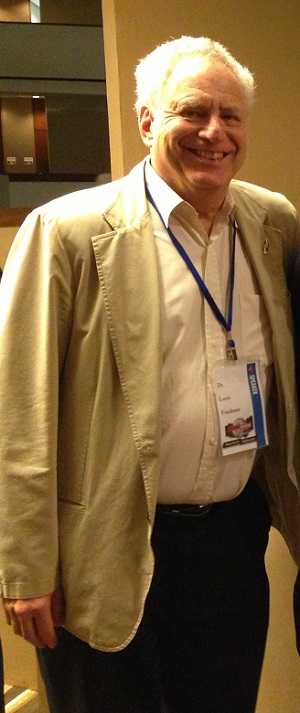
Much of the impetus for a NASA sail study in the 1970s — a $4 million effort at the Jet Propulsion Laboratory in 1977 and 1978 — can be traced back to Jerome Wright, an engineer at the Battelle Memorial Institute in Ohio. In his book Starsailing: Solar Sails and Interstellar Travel (John Wiley & Sons,1988), Friedman recalls a meeting of the Advanced Projects Group at the Jet Propulsion Laboratory in which he learned about Wright’s newest idea from Chauncey Uphoff, a senior member of JPL’s mission design section. Friedman describes the event:
Then, at the group meeting, Chauncey Uphoff and Phillip Roberts dropped the bombshell. “Jerry Wright has found a possible way to rendezvous with Halley’s Comet,” Chauncey announced.
“You mean fly-by, not rendezvous,” I said.
“No, I mean rendezvous.”
“With a trip time of ten years?”
“Would you believe four years?”
Image: Louis Friedman, former executive director of The Planetary Society and one of its founders, who led NASA’s study of a solar sail mission to Halley’s Comet.
Wright’s book Space Sailing (Routledge, 1992) lays out the basic concepts behind solar sails and the principles behind navigating with a sail in space — it was Wright who first realized that Halley’s Comet’s 1986 appearance in the inner Solar System offered a chance to try the technology out on an actual mission. Wright would be invited to conduct a seminar at JPL on sail techniques in May of 1975 that led to his joining the small team there in December of that year, with NASA’s approval of a study to design a vehicle and mission concept to the comet.
We’ve looked at solar sailing frequently on Centauri Dreams and traced the development of the idea from the first technical paper, Carl Wiley’s “Clipper Ships of Space,” which appeared in Astounding Science Fiction in May of 1951. Wiley, of course, built on ideas dating back to the time of Kepler, with major work accomplished by Konstantin Tsiolkovsky and Fridrickh Arturovich Tsander in the early part of the 20th Century. It’s interesting to learn from Friedman’s book that Wiley, then working as an engineer at Rockwell, came to some of the technical presentations at JPL as the Halley’s Comet idea was discussed.
Friedman credits Ted Cotter, working at Los Alamos, with the first presentation of a spinning sail. See A Sail Mission Emerges for more on Cotter’s ideas, and be aware that his 1958 memorandum “An Encomium on Solar Sailing,” distributed internally at Los Alamos, is now online. Spinning the sail helps because it allows the sail to be stabilized without the help of an external structure. I should also mention Richard Garwin, whose paper on solar sails that same year led to a lifetime of interest in the concept. Friedman credits Garwin with helping to inspire NASA’s later interest in a sail mission, leading NASA administrator James Fletcher to commission studies on sails that were assigned to Jerome Wright during his days at Batttelle.
So we can see a flurry of sail interest in the agency in the mid-1960s — an early meeting on solar sail design was actually held at NASA’s Langley Research Center as early as 1960 — but with the end of the Apollo missions, a dwindling space program had no plans for specific missions. Thus at the time Jerome Wright began talking about a Halley’s Comet mission in the mid-1970s, little other work was being done on sail technologies. Wright was more or less the only game in town.
Friedman recalls the situation:
Then Wright found the Halley rendezvous opportunity. By the time the JPL study team began its task, two major developments had occurred. First, NASA was developing the space shuttle, which promised to carry large-volume payloads into orbit. Second, there had been great advancements in the technology of deploying huge structures in space. The shuttle also made it possible for scientists to test space concepts, and the JPL study team hoped to test the solar sail from a shuttle in orbit.
The positive results of the 1976 and early 1977 JPL studies captured the imagination of the new director of the Jet Propulsion Laboratory, Dr. Bruce Murray. With his approval, the study team made a major effort to put together a project plan for a rendezvous with the comet. This work, however, had to be done rapidly. In order to launch in late 1981, the project would have had to start moving by the end of 1978. 1 was put in charge of the study and we quickly wrote a proposal for a one-year study and gave it to NASA.
The original NASA design called for a sail of 800 meters to the side supported by four diagonal cross beams, to be launched by the Space Shuttle in 1981. But in 1977 a ‘heliogyro’ approach invented in the mid-1960s by Richard MacNeal and John Hedgepath won out, featuring 12-kilometer long sails made up of narrow strips that would spin up like helicopter blades to keep the sail rigid. Unlike the earlier design, the heliogyro could use centrifigual force from its spin to unreel the blades from storage drums, thus requiring no human assembly in orbit.
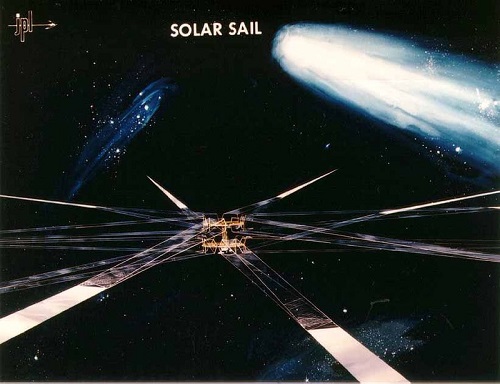
Image: An artist’s conception of the Halley’s Comet heliogyro design. Credit: JPL.
NASA’s acceptance of the proposal led to the design study that brought in industrial contractors, included support from NASA Ames and Langley, work that resulted in the conclusion that solar sailing was indeed feasible. The question, though, was whether it was practical to speak in terms of a Halley’s Comet rendezvous given the time constraints involved. NASA would ultimately turn down the proposal as being based on a technology that was not sufficiently mature. When I asked Dr. Friedman about this at the last 100 Year Starship symposium, he said NASA was probably right. The Halley’s sail was pushing too far, too fast for its time.
Cost was a factor as well, with a price tag estimated at $500 million — remember the budgetary morass NASA found itself in with Space Shuttle cost overruns in this era. Other comet missions were considered, but in the end the United States did not launch a dedicated mission to Halley’s Comet. The story of comet rendezvous, the Giotto mission from ESA, the Soviet Vega spacecraft and the Japanese Suisei and Sakigake probes, makes for fascinating reading, but in terms of solar sails, it would be a long wait before JAXA’s IKAROS sail took flight in 2010. Before then, though, Louis Friedman would be involved in other attempts, one of which we’ll discuss tomorrow.


